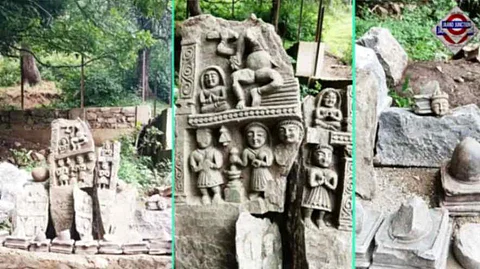

A set of ancient Hindu idols and Shivlings, believed to be around 1400 years old, was discovered during a spring restoration project in South Kashmir’s Anantnag district. The discovery was made at the Karkoot Nag spring, located in the Salia area of Aishmuqam, roughly 16 km from Anantnag town.
The site is of major historical and religious significance, especially for the Kashmiri Pandit community. Historians believe this location is connected to the Karkoota dynasty that ruled Kashmir between the 7th and 9th centuries CE.
The digging was part of a local effort to fix up the natural spring. While working, labourers unexpectedly came across ancient artefacts buried under layers of soil and stone. Officials rushed to the spot soon after being informed.
Officials from the Jammu and Kashmir Department of Archives, Archaeology and Museums arrived soon after to assess and secure the findings. The department has now taken charge of the relics to keep them safe.
“These sculptures and idols are significant. They will be transferred to the SPS Museum in Srinagar, where our team of experts and research scholars will examine them closely to establish their exact period and cultural importance,” a senior archaeology official told PTI.
Karkoot Nag has long been mentioned in historical records and oral traditions, particularly in Kashmiri Hindu texts. However, this is one of the few times that physical evidence has emerged from the site, giving historians a rare chance to learn more about Kashmir’s early medieval dynasties.
Local residents, especially from the Kashmiri Pandit community, expressed both excitement and hope following the discovery. Many are now urging the government to preserve the site and consider restoring a temple at the location.
“It’s more than just old stones. This is our shared heritage. We hope the administration recognises the cultural value of this place and takes steps to protect and revive it,” said a resident from the area.
The Karkoota dynasty, which is often associated with cultural growth and regional stability in early Kashmir, played a key role in shaping the valley’s ancient identity. The rulers of this dynasty were known patrons of Hindu art and architecture, making these findings even more relevant.
Finding these well-preserved relics gives a rare look into the region’s religious and artistic history. It also adds physical proof to historical records about the existence and cultural influence of the Karkoota dynasty, a relatively under-researched period in Kashmiri history.
The fact that these idols were found at a spring—considered sacred in many Hindu traditions, adds to the spiritual value of the site. Springs like Karkoot Nag were often pilgrimage spots and believed to be places of divine presence.
The SPS Museum in Srinagar will be the next stop for the recovered idols and Shivlings. There, researchers will clean, study, and possibly date the artefacts using scientific techniques. This will help build a clearer timeline of when the items were created and what they can tell us about the religious and cultural practices of that era.
The Department of Archives and Archaeology may also consider further excavation in the area to see if more relics lie buried nearby.
Conclusion:
This surprise discovery at Karkoot Nag spring is a valuable window into Kashmir’s ancient past. As archaeologists begin their research, locals and heritage lovers alike hope the site will be preserved and honoured for its deep historical and religious meaning. With the right care, this could become more than a museum piece,it could be a restored cultural landmark for the area.
